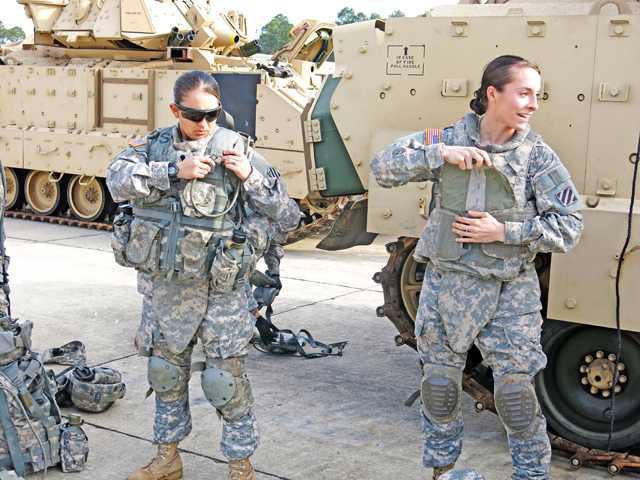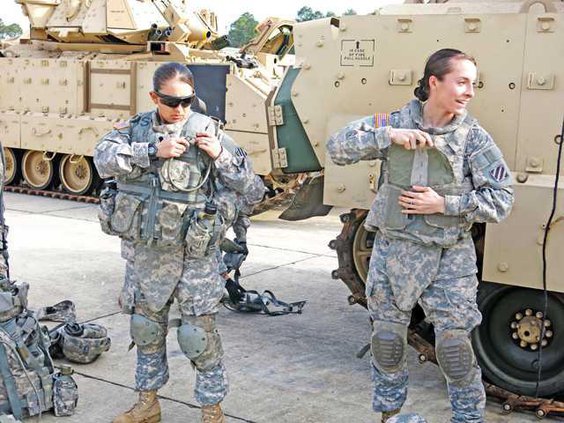About 160 soldiers with the 3rd Infantry Division’s 2nd Armored Brigade Combat Team are taking part in a gender-integration study for the Army’s Training and Doctrine Command and the U.S. Army Research Institute of Environmental Medicine. The five-week long Physical Demand Study began three weeks ago, said Lt. Col. Mark Olsen, commander of 1st Battalion, 30th Infantry Regiment.
“Our goal is to provide useful scientific data that can be used to determine how much upper-body strength is required to do the job of an infantryman, mortar man, tanker and scout,” said Olsen, whose unit is conducting the training. “We have 58 female soldiers who’ve volunteered to participate in the study.”
Company D commander, Capt. Jamal Kahn, said they put together four gender-integrated platoons, each consisting of 15 females and 25 males — one infantry platoon, one mortar platoon, one tank platoon and one scout platoon. Staff Sgt. Terry Kemp, the scout platoon sergeant, said the experience level of the male and female soldiers was about the same, noting that the male volunteers were not infantrymen.
Company D 1st Sgt. Jason Hall said the focus of the training and later testing will be on the female soldiers; however, the male soldiers go through the same training and testing.
According to a TRADOC video called “Soldier 2020: Standard for the Army Professional,” data from gender-integration studies conducted at five Army installations will be used to determine the physical exertion required to perform specific tasks. The Army’s Infantry School and Armor School said these tasks are required in order to be an infantryman or tanker — military occupational specialties historically denied to female soldiers.
The video said the data from the studies will be used to develop a physical-fitness assessment that would be used by recruiters to determine if a potential recruit physically is capable of being an infantryman. One researcher in the video said the data might help the Army by revealing that some soldiers already in the infantry are not physically capable of doing the job. This information may help prevent some of the injuries common to the military occupation specialties, she said.
According to www.benning.army.mil/infantry/infantry.htm, Army recruits who enlist for the infantry are sent to a one-station basic and advanced individual training. As recruits are trained to become soldiers, they develop muscles many have not used in civilian life. Those who complete basic training then begin advanced individual training where they continue to develop physically in order to perform the physically-demanding tasks required of an infantryman who must work as part of an infantry fire team, squad, platoon and company.
3rd ID public affairs Master Sgt. Corey Vandiver said special-operation units are not taking part in the study because Rangers and Special Forces remain closed to females. He said the Army has stated the standard requirements to be an infantryman will not change.
However, according to a Jan. 3 article by Elizabeth Dilts for www.rueters.com, the Marine Corps changed its demand that female infantry recruits be able to do a minimum of three pull-ups as part of the physical fitness test. About 55 percent of female recruits failed to do the same minimum number of pull-ups required of male recruits. This led the Corps to delay indefinitely the pull-ups requirement for females in the infantry.
On Tuesday and Wednesday, members of the media were invited to observe soldiers participating in the Physical Demands Study. Tasks observed included loading then unloading 36 rounds of dummy 155mm rounds for an M-1 Abrams tank, loading then unloading two dummy TOW missiles in a Bradley Fighting Vehicle’s missile launcher and removing the 109-pound barrel of a Bradley. This was a two-man task.
“I was picking up the (dummy 155mm) round and taking it to the tank,” said Spc. Shiniah McKinney, who said the dummy rounds weighed 35-40 pounds. “You have to hold the round carefully like it was a newborn baby ... You do have to be physically strong to do this but not very strong. You should be able to lift half your body weight.”
McKinney, whose military occupational specialty is human intelligence, would like to join the infantry. She said when she was deployed to Afghanistan, she was attached to an infantry unit. Master Sgt. Serena Mitchell, a food-service noncommissioned officer with 25 years in the Army, said she’d like to have been in the infantry when she was younger.
“If I was just coming in the Army, I would be interested,” Mitchell said. “At this time in my career, I just enjoy doing the physical challenge of the study, which will help gather data for when they do incorporate females in the infantry.”
Sgt. 1st Class Joseph Hilbig, noncommissioned officer in charge of the scout platoon, said the soldiers in the study will continue to train and develop the “muscle memory” necessary to do the tasks for which they’ll be tested on starting next week.
The testing will conclude with a 24-hour training exercise that includes a 12-mile road. Each soldier will wear more than 110 pounds of equipment called Marne Standard gear, including helmet, body armor, load-carrying vest, assault pack and weapon.
Study gives women taste of combat
Exercise assesses physical demands


Sign up for our e-newsletters